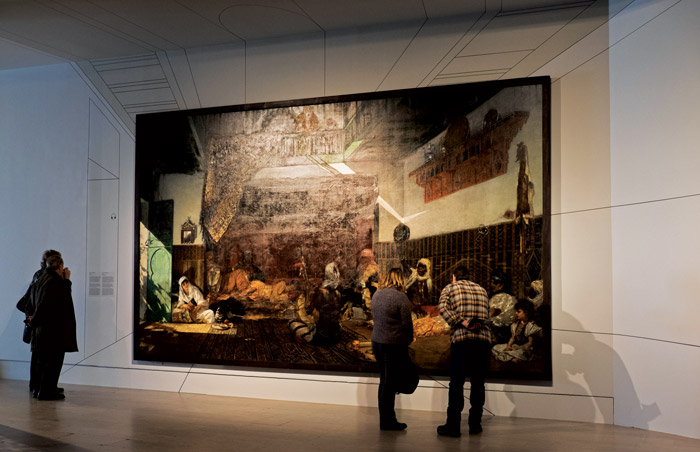In the midst of the frozen pipes, depressing darkness, and the icy sidewalks that accompany a typical Montreal winter, the Montreal Museum of Fine Arts (MMFA) is almost taunting the city to attend its sun-filled Marvels and Mirages of Orientalism exhibit currently on display.
Focusing on the juxtaposition between the “staged pictorial” works of French Orientalist artists—most notably Benjamin-Constant (1845-1902)—and “documented realities” embodied in various drawings and photographs, the exhibit sets out to simultaneously reveal the raw beauty and gross stereotyping that characterizes the genre. The MMFA brilliantly succeeds in stimulating viewers’ imaginations, drawing them into a temporal snapshot of the past like moths to a light, only to smack them out of their stupor with pieces that reveal the stereotypes they might have just bought into.
As a direct result of Napoleon’s campaign into Egypt and Syria in 1798-1801 and France’s colonial acquisition of Algeria in 1830, French Orientalism reflected the French public’s growing curiosity towards North African culture. Faced with a culture that was close geographically—yet so religiously and politically different—French artists, such as Benjamin-Constant, took to painting the hectic city life, serene desert landscapes, and women of the Orient.
European fascination, however, quickly blurred into a form of romanticized stereotyping. The Orient as a whole was overly eroticized, women were objectified as mere components of a harem, and an increasing sense of North Africa’s ‘timelessness’, or lack of history, pervaded this inherently Eurocentric and colonial art style. This historical narrative behind Orientalism unfolds alongside the stunning art pieces of the exhibit in the form of wall-mounted paragraphs beside each work of art, and crucially grounds viewers in reality when faced with the “golden cage” of the harem.
From the very entrance of the exhibit the beauty and scale of the paintings are immediately apparent. George Rochegrosse’s Salome Dancing Before King Herod captures the complex intricacies of Moorish Architecture, captivating due to the fact that the buildings themselves seem impossible to build, let alone paint. Benjamin-Constant’s massive paintings The Last Rebels and The King Of Morocco Leaving to Receive a European Embassy both offer a glimpse into North African political organization, depicting the Sultan accompanied by the traditional royal parasol, and are stimulating from a historical perspective. At the same time, grand distortions of history are also frequent and most clearly seen in the Death of Cleopatra, by Jean Andre-Rixens, where history borders erotic-fantasy.
The highlights of the exhibit, however, are the three contemporary Moroccan artists Yasmina Bouziane, Lalla Essaydi and, Majida Khattari, “who were invited to address these stereotypes” found in Orientalism. Lalla Essaydi’s piece Harem No. 2 is particularly striking—her photograph portrays a woman wearing a patterned blue dress seated upon a divan with the same pattern.
This direct union between object and human, a critical response to the objectification of women found in Oriental Art, is powerfully effective in bringing these pejorative stereotypes to the fore. Essaydi “overwrites” the body of women to divert the common “voyeuristic gaze” and address the issues of “confining cultural attitudes.” The works of all three Moroccan artists seek to reclaim the artistic tradition embodied in Orientalism, but divorce it from the objectifying and restricting ideologies that unfortunately accompany it. This modern endeavour, after spending more than an hour and a half immersed in historically pejorative—albeit aesthetically beautiful—art pieces was a nice conclusion to the exhibit.
Marvels and Mirages of Orientalism ultimately offers viewers the chance to be genuinely swayed by the dreamy Orientalist depictions of 19th century North African culture, but in a way culturally correct that manages to still preserve the aesthetic beauty of the movement.
Marvels and Mirages of Orientalism runs until May 31, 2015 at the Montreal Museum of Fine Arts (1380 Sherbrooke Ouest). Student admission is $12 and $10 on Wednesday evenings.









Pingback: Montreal Museum of Fine Arts: Marvels and Mirages of Orientalism | Culture Proof